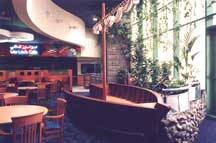
Vol. III, No. 2, February 2003
- Quality-of-Place
- The Only 5 Ways to Grow Your Business?
- Foundations! April 29 - May 1, Chicago
- Performance Monitoring
- Are Family Facilities Out of Sync With Family Norms?
- The Butt-brush Factor & Proxemics
- Financing Source
- Putting the Family Back into LBL's
- ADA & Universal Design
- Free Magazine Subscription
Quality-of-Place
Ambiance, atmosphere, theming, lighting, color, comfort, colors, acoustics, wayfinding, architecture, shade, landscaping, views, anthropometrics, mood, texture, scale - these are words that can be used to describe different characteristics of entertainment, leisure and recreational environments. Over the years, we have written many articles discussing how many of these characteristics relate to designing successful located-based leisure (LBL) facilities. We have finally found a term that encompasses them all - quality-of-place.
Quality-of-place is a critical factor to the success of LBLs, especially those targeting families and young adults. Unfortunately, many segments of the LBL industry have developed a conventional wisdom that quality-of-place is not important to their success. Many of those projects have joined the graveyard of industry roadkill.
The best example I can offer are many FECs that have located in warehouse-type environments that basically just place a lot of games and rides in a warehouse space. Little, other than some paint and a mural are added to the indoors. Another example are outdoor FECs that could best be described as concrete deserts where landscaping and shade is totally lacking. I'm sure at one time you've visited one of these facilities. These facilities are noisy, cavernous, and generally uninviting for the family market. They are just as inviting as a Chili's, or Applebee's, or any other restaurant would be if it were just tables place in the middle of a similarly unfinished space.
The teenage market is a different story. Teens seem to like the opposite of what appeals to families, and especially moms. To teens, quality-of-place is defined completely differently than it is for adults and younger children. Those warehouses probably work fine for teens. However, this article is not about designing for teens, it about designing for the two largest leisure markets, families and young adults.
The explanation for the warehouse and concrete desert paradigm probably has its roots in the early days of the FEC industry. When the first indoor FEC facilities were developed in the early 90's, entrepreneurs turned to the carnival, seaside boardwalk amusement park and teen-oriented, mall game room models. The idea was to locate similar entertainment facilities indoors in suburban locations and attract families. So they found what spaces they could, spent as little as possible on remodeling the spaces, moved in the equipment and opened the doors to the public.
So what happened next? A new entrepreneur decides to develop another entertainment facility and models it after the only ones out there. The conventional wisdom was born.

Children can pretend fish from a boat in this White Hutchinson designed center that offers quality-of-place to parents who can sit and watch their children from the adjoining café
Time has proved that conventional wisdom to be nothing but a myth. What works for a carnival or seaside boardwalk is completely different than what works for community-based facilities requiring high repeat business to succeed. In today's world, community facilities need to have a quality-of-place that matches the target markets' tastes, values and expectations to succeed. And the more upscale the market that is targeted, the higher the quality-of-place required for long-term success.
Community-based leisure facilities are very unique and complex. Their market dynamics and economics are completely different from other types of entertainment facilities such as tourist attractions and amusement parks. Their design requires specialized and unique knowledge and skills. It requires expertise and an understanding of the multi-dimensional aspects of not only the physical facility and its equipment, but also the business operations and economics. Success requires an appropriate quality-of-place, mix, layout and adjacencies, and a facility that can be efficiently managed. To often LBL developers fail to understand how unique LBL facilities are and turn to local architects for their design. Sometimes, they even try to be their own designers. The problem with acting as your own designer or using a local architect who may be a good generalist designer, but is not specialized in LBL design, is that due to a lack of knowledge and expertise, many mistakes will be made, creating a permanent handicap to the business's success.
If you are thinking about developing an LBL, we urge you to retain a specialist in the design of your type facility. Don't try to cut corners and save money by doing it yourself or by working with a generalist. You will regret it later when it is too late or too expensive to make corrections.
In the upcoming month's, our Leisure eNewsletter will included articles that discuss different aspects of creating quality-of-place. This issue includes two such articles:
Vol. III, No. 2, February 2003
- Quality-of-Place
- The Only 5 Ways to Grow Your Business?
- Foundations! April 29 - May 1, Chicago
- Performance Monitoring
- Are Family Facilities Out of Sync With Family Norms?
- The Butt-brush Factor & Proxemics
- Financing Source
- Putting the Family Back into LBL's
- ADA & Universal Design
- Free Magazine Subscription



